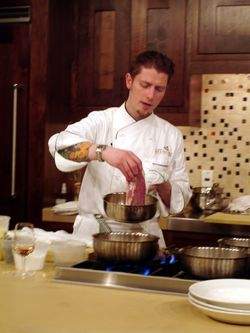By Jason Feulner, Finger Lakes Correspondent
 Despite my relationship to Lenn and this blog, my encounters with Long Island wine have been ad hoc: a wine here, and a wine there, but never a firm introduction to what the region has to offer. With this in mind, I jumped at the chance the other day to attend a Long Island Merlot dinner at the New York Wine and Culinary Center in Canandaigua.
Despite my relationship to Lenn and this blog, my encounters with Long Island wine have been ad hoc: a wine here, and a wine there, but never a firm introduction to what the region has to offer. With this in mind, I jumped at the chance the other day to attend a Long Island Merlot dinner at the New York Wine and Culinary Center in Canandaigua.
The event was held in cooperation with the Long Island Merlot Alliance, an organization dedicated to the research and promotion of quality merlot production within the Long Island wine community. The Merlot Alliance currently has seven member wineries and hopes to attract more since most if not all Long Island wineries produce merlot.
This event was my first wine dinner at the Wine and Culinary Center, and it was tremendous experience. Head chef Carlo Peretti (pictured at right) is a delightful host and his display cooking was engaging and fun.
Our courses consisted of Montauk Scallops with Beet Iced Mignonette, Long Island Duck Breast with Braised Apple and Cabbage Slaw, Pan Roasted New York State Bison Fillet, and for dessert a Raspberry Chocolate Pot de Creme.
All of the food was excellent.
At a typical dinner I would have been satisfied with the scallops, duck, or bison by themselves, but in this case I reveled in all three. In addition, the chef paired these dishes nicely with the lineup of Long Island merlot.
 Clovis Point winemaker John Leo (picutred at right) provided tasting commentary with some support from Donnell Brown, executive director of the Merlot Alliance. Overall, the lineup of wines offered was extremely interesting. It consisted of no outright show-stoppers but each wine provided some inherent quality and a few stood out from the rest.
Clovis Point winemaker John Leo (picutred at right) provided tasting commentary with some support from Donnell Brown, executive director of the Merlot Alliance. Overall, the lineup of wines offered was extremely interesting. It consisted of no outright show-stoppers but each wine provided some inherent quality and a few stood out from the rest.
Within the group, the 2004 Clovis Point excelled for being very much a balance of the various styles presented, a middle-of-the-pack wine not in quality but in terms of it emphasis on fruit vs. oak, the straight merlot flavor vs. other blended varietals.
The Merliance 2006 merlot, a 100% merlot blend of the merlot lots of the LIMA member wineries, stood in contrast to the rest with its fruit-forward, simple taste highlighting the qualities of merlot as its own grape. In a completely different style to the Merliance, the 2004 Sherwood House utilized a Bordeaux-style blend to create a subtle, earthy wine balanced with the flavors of cabernet sauvignon and petit verdot.
One of the tasting treats offered by Pellegrini was their 1997 merlot, a wine that was probably just past its peak but nonetheless had all the beautiful elements of a well-aged, quality red, providing bright fruit with dusky flavors and textures.
A 2007 McCall Vineyard merlot was still in bottle shock, yet the warm vintage seemed apparent and this wine seems ready to expand its profile once it has a little more time in the bottle.
With dessert we tried a 2007 Raphael Merlot Port, a wine that didn't blow me away but provided for a lovely after-dinner drink. The idea of a merlot port-style wine intrigues me and I think the flavors work to some degree-I hope to taste such a wine again.
I left the wine dinner with two main conclusions: Namely, wine dinners at the Culinary Center come highly recommended (they hold them very often, usually with winery-specific themes), and Long Island merlot provides a diverse lineup of styles. If this small lineup is any indication, merlot can find expression in a variety of ways within Long Island. The merlot grape seems to provide an excellent anchor in terms of defining Long Island reds and the terroir that produces them.
